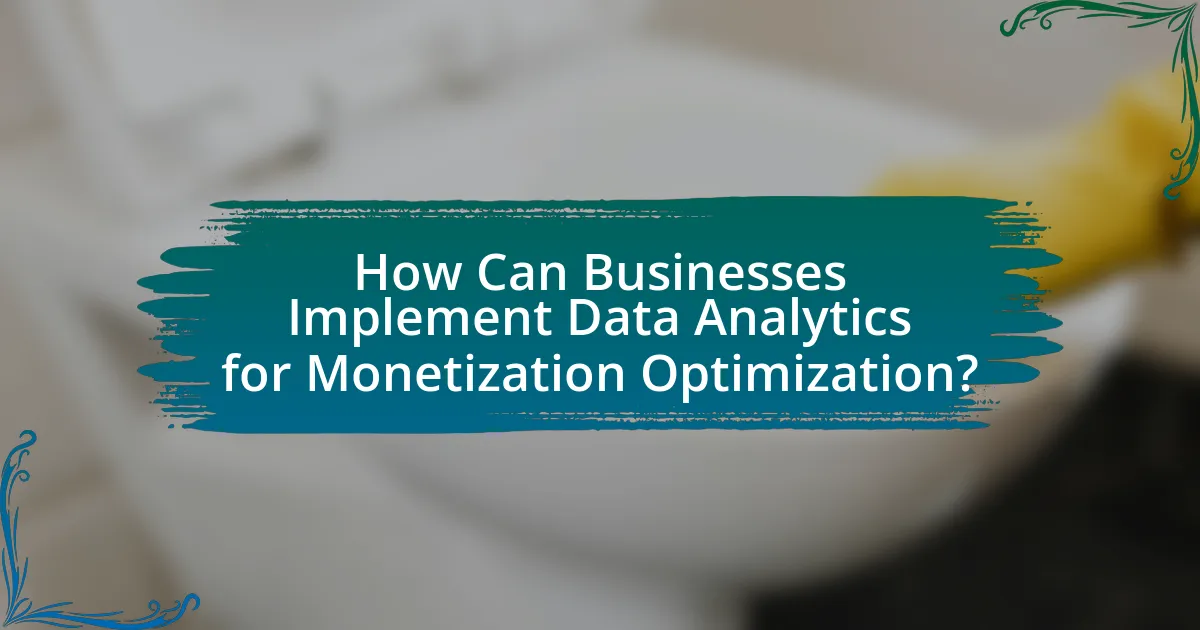Data analytics plays a crucial role in optimizing monetization strategies by systematically analyzing data to uncover patterns and insights that enhance revenue generation. The article explores how data analytics contributes to improved pricing models, customer segmentation, and targeted marketing efforts, ultimately driving profitability. Key components of data analytics, including data collection, processing, analysis, and visualization, are discussed, along with the various types of analytics such as descriptive, diagnostic, predictive, and prescriptive analytics. Additionally, the article highlights the importance of data-driven insights in shaping monetization decisions, the advantages over traditional methods, and best practices for successful implementation, including continuous monitoring and cross-department collaboration.

What is Data Analytics in the Context of Monetization Strategies?
Data analytics in the context of monetization strategies refers to the systematic analysis of data to identify patterns, trends, and insights that can enhance revenue generation. By leveraging data analytics, businesses can optimize pricing models, improve customer segmentation, and tailor marketing efforts to maximize profitability. For instance, a study by McKinsey & Company found that companies using advanced analytics in their monetization strategies can increase their operating income by 10-20%. This demonstrates that effective data analytics not only informs decision-making but also drives significant financial outcomes.
How does data analytics contribute to optimizing monetization strategies?
Data analytics significantly enhances monetization strategies by providing actionable insights into customer behavior and market trends. By analyzing data, businesses can identify which products or services generate the most revenue, allowing for targeted marketing efforts and optimized pricing strategies. For instance, a study by McKinsey & Company found that companies leveraging data analytics can increase their operating margins by 60% through improved decision-making and resource allocation. This data-driven approach enables organizations to tailor their offerings to meet customer demands effectively, ultimately maximizing revenue potential.
What are the key components of data analytics in monetization?
The key components of data analytics in monetization include data collection, data processing, data analysis, and data visualization. Data collection involves gathering relevant information from various sources, such as user interactions and transaction records. Data processing transforms raw data into a structured format, enabling easier analysis. Data analysis employs statistical methods and algorithms to identify trends, patterns, and insights that inform monetization strategies. Finally, data visualization presents these insights in an accessible format, allowing stakeholders to make informed decisions. Each component plays a crucial role in optimizing monetization strategies by providing actionable insights that drive revenue growth.
How do data-driven insights influence monetization decisions?
Data-driven insights significantly influence monetization decisions by providing empirical evidence that guides pricing strategies, product offerings, and customer targeting. Companies analyze user behavior, market trends, and financial performance metrics to identify the most profitable segments and optimize revenue streams. For instance, a study by McKinsey & Company found that organizations leveraging data analytics can increase their profitability by 5-6% through more informed pricing and product development decisions. This empirical approach enables businesses to adapt quickly to market changes and consumer preferences, ensuring that monetization strategies are aligned with actual demand and maximizing financial outcomes.
Why is it important to utilize data analytics for monetization?
Utilizing data analytics for monetization is crucial because it enables businesses to make informed decisions that enhance revenue generation. Data analytics provides insights into customer behavior, preferences, and market trends, allowing companies to tailor their products and services effectively. For instance, a study by McKinsey found that organizations that leverage data-driven decision-making are 23 times more likely to acquire customers and 6 times more likely to retain them. This demonstrates that data analytics not only improves customer engagement but also drives profitability by optimizing pricing strategies and identifying new market opportunities.
What advantages does data analytics provide over traditional methods?
Data analytics provides significant advantages over traditional methods by enabling more accurate decision-making through data-driven insights. Unlike traditional methods that often rely on intuition or limited data sampling, data analytics utilizes large datasets and advanced algorithms to identify patterns and trends, leading to more informed strategies. For instance, a study by McKinsey & Company found that organizations using data analytics are 23 times more likely to acquire customers, 6 times more likely to retain customers, and 19 times more likely to be profitable. This demonstrates that data analytics not only enhances operational efficiency but also drives revenue growth by optimizing monetization strategies based on real-time data analysis.
How can data analytics enhance customer understanding and engagement?
Data analytics enhances customer understanding and engagement by providing insights into customer behavior, preferences, and trends. By analyzing data from various sources such as purchase history, website interactions, and social media activity, businesses can identify patterns that reveal what customers value most. For instance, a study by McKinsey found that companies using advanced analytics to understand customer behavior can increase their marketing ROI by 15-20%. This data-driven approach allows businesses to tailor their offerings and communication strategies, leading to more personalized experiences that foster deeper customer relationships and higher engagement levels.

What are the Different Types of Data Analytics Used in Monetization?
The different types of data analytics used in monetization are descriptive analytics, diagnostic analytics, predictive analytics, and prescriptive analytics. Descriptive analytics focuses on summarizing historical data to understand trends and patterns, which helps businesses assess past performance. Diagnostic analytics goes further by identifying the reasons behind those trends, allowing companies to understand what factors influenced their revenue. Predictive analytics utilizes statistical models and machine learning techniques to forecast future outcomes based on historical data, enabling businesses to anticipate customer behavior and optimize pricing strategies. Finally, prescriptive analytics recommends actions based on data analysis, guiding businesses on the best strategies to maximize revenue. Each type of analytics plays a crucial role in informing monetization strategies and enhancing decision-making processes.
What are descriptive analytics and how do they apply to monetization?
Descriptive analytics refers to the process of analyzing historical data to identify trends, patterns, and insights that can inform decision-making. In the context of monetization, descriptive analytics helps businesses understand customer behavior, sales performance, and market trends, enabling them to optimize pricing strategies, improve product offerings, and enhance customer engagement. For instance, a study by the International Data Corporation (IDC) found that organizations leveraging descriptive analytics can increase their revenue by up to 10% by making data-driven decisions that align with consumer preferences and market demands.
How can descriptive analytics inform pricing strategies?
Descriptive analytics can inform pricing strategies by analyzing historical sales data to identify trends and customer behavior patterns. This analysis allows businesses to understand which products are most popular at different price points, enabling them to set competitive prices that maximize revenue. For instance, a study by McKinsey & Company found that companies using data-driven pricing strategies can increase profits by 2-7%. By leveraging insights from descriptive analytics, businesses can adjust their pricing in response to market demand, seasonality, and customer preferences, ensuring that their pricing strategies are aligned with actual market conditions.
What role does historical data play in shaping future monetization efforts?
Historical data is crucial in shaping future monetization efforts as it provides insights into past consumer behavior, revenue trends, and market dynamics. By analyzing historical data, businesses can identify patterns and correlations that inform pricing strategies, product offerings, and marketing campaigns. For instance, a study by McKinsey & Company found that companies leveraging historical data analytics can increase their revenue by 10-20% through more targeted and effective monetization strategies. This evidence underscores the importance of historical data in making informed decisions that enhance profitability and optimize resource allocation in future monetization efforts.
What is predictive analytics and its significance in monetization strategies?
Predictive analytics is a branch of data analytics that uses statistical algorithms and machine learning techniques to identify the likelihood of future outcomes based on historical data. Its significance in monetization strategies lies in its ability to forecast customer behavior, optimize pricing models, and enhance marketing efforts, ultimately leading to increased revenue. For instance, a study by McKinsey & Company found that companies using predictive analytics can improve their marketing ROI by up to 15-20%, demonstrating its effectiveness in driving financial performance.
How can predictive models forecast revenue streams?
Predictive models forecast revenue streams by analyzing historical data and identifying patterns that influence future financial performance. These models utilize statistical techniques and machine learning algorithms to project potential revenue based on variables such as customer behavior, market trends, and economic indicators. For instance, a study by McKinsey & Company found that companies using predictive analytics can improve their revenue forecasting accuracy by up to 20%, enabling more informed decision-making and strategic planning.
What factors are considered in predictive analytics for monetization?
Predictive analytics for monetization considers several key factors, including customer behavior, market trends, pricing strategies, and historical sales data. Customer behavior analysis helps identify purchasing patterns and preferences, enabling businesses to tailor their offerings. Market trends provide insights into demand fluctuations and competitive positioning, which are crucial for strategic planning. Pricing strategies are evaluated to determine optimal price points that maximize revenue while remaining attractive to consumers. Historical sales data serves as a foundation for forecasting future performance, allowing businesses to make informed decisions based on past outcomes. These factors collectively enhance the accuracy of predictive models, leading to more effective monetization strategies.

How Can Businesses Implement Data Analytics for Monetization Optimization?
Businesses can implement data analytics for monetization optimization by leveraging customer data to identify purchasing patterns and preferences. By analyzing transaction histories and customer interactions, companies can segment their audience and tailor marketing strategies to specific groups, enhancing engagement and conversion rates. For instance, a study by McKinsey found that companies using advanced analytics can increase their marketing ROI by 15-20%. Additionally, businesses can utilize predictive analytics to forecast demand and optimize pricing strategies, ensuring they maximize revenue opportunities. This data-driven approach not only improves decision-making but also aligns product offerings with market needs, ultimately driving profitability.
What steps should businesses take to integrate data analytics into their monetization strategies?
Businesses should first assess their current data capabilities and identify key performance indicators (KPIs) relevant to their monetization strategies. This foundational step allows organizations to understand what data they have and how it can inform revenue generation. Next, they should invest in the right data analytics tools and technologies that align with their business goals, enabling them to collect, analyze, and visualize data effectively.
Following this, businesses must establish a data-driven culture by training employees on data literacy and encouraging data-informed decision-making across all levels. This cultural shift is crucial for maximizing the impact of data analytics on monetization strategies. Additionally, companies should continuously monitor and evaluate the effectiveness of their analytics initiatives, using insights gained to refine their monetization approaches and adapt to market changes.
Finally, collaborating with data scientists or analytics experts can enhance the integration process, ensuring that businesses leverage advanced analytical techniques to uncover new revenue opportunities. This structured approach, supported by evidence from successful case studies, demonstrates that organizations that effectively integrate data analytics into their monetization strategies can achieve significant revenue growth and competitive advantage.
How can organizations identify the right tools for data analytics?
Organizations can identify the right tools for data analytics by assessing their specific data needs, evaluating tool capabilities, and considering user-friendliness. First, organizations should define their objectives, such as improving customer insights or enhancing operational efficiency, which helps narrow down the tools that align with these goals. Next, they must evaluate the capabilities of various tools, including data visualization, machine learning, and integration with existing systems, to ensure they meet the technical requirements. Additionally, user-friendliness is crucial; tools that require extensive training may hinder adoption. According to a survey by Gartner, 70% of organizations cite ease of use as a critical factor in tool selection, highlighting its importance in the decision-making process.
What skills are necessary for teams to effectively utilize data analytics?
Teams need a combination of technical, analytical, and communication skills to effectively utilize data analytics. Technical skills include proficiency in data manipulation tools such as SQL, Python, or R, which enable teams to extract and analyze data efficiently. Analytical skills involve the ability to interpret data trends and patterns, allowing teams to derive actionable insights that can inform monetization strategies. Communication skills are essential for presenting findings clearly to stakeholders, ensuring that data-driven recommendations are understood and implemented. Research indicates that organizations with strong data analytics capabilities can achieve up to 5-6% higher productivity and profitability, highlighting the importance of these skills in optimizing monetization strategies.
What challenges might businesses face when utilizing data analytics for monetization?
Businesses face several challenges when utilizing data analytics for monetization, including data quality issues, integration complexities, and skill gaps. Data quality issues arise when the data collected is inaccurate or incomplete, leading to unreliable insights. Integration complexities occur when businesses struggle to combine data from various sources, which can hinder the ability to generate a comprehensive view of customer behavior. Additionally, skill gaps in data analysis and interpretation can prevent organizations from effectively leveraging analytics, as a lack of expertise may result in misinterpretation of data or failure to implement actionable strategies. According to a report by McKinsey, 70% of organizations cite insufficient data skills as a barrier to successful analytics implementation.
How can data privacy concerns impact analytics efforts?
Data privacy concerns can significantly hinder analytics efforts by limiting the availability and usability of data. When organizations prioritize data privacy, they often implement stricter data governance policies, which can restrict access to valuable datasets needed for comprehensive analysis. For instance, regulations like the General Data Protection Regulation (GDPR) impose heavy fines for non-compliance, prompting companies to minimize data collection and anonymize datasets, thereby reducing the granularity of insights. This limitation can lead to less accurate predictions and hinder the ability to tailor monetization strategies effectively, as businesses may lack the necessary data to understand customer behavior fully.
What are common pitfalls in data interpretation that can affect monetization?
Common pitfalls in data interpretation that can affect monetization include misinterpretation of data trends, over-reliance on correlation without understanding causation, and ignoring data quality issues. Misinterpretation of data trends can lead to incorrect business decisions; for example, a company may mistakenly identify a seasonal spike in sales as a long-term growth trend, resulting in misguided investment strategies. Over-reliance on correlation can mislead organizations into believing that two variables are causally related when they are not, potentially leading to ineffective marketing strategies. Ignoring data quality issues, such as incomplete or inaccurate data, can result in flawed analyses that misrepresent customer behavior and preferences, ultimately harming monetization efforts. These pitfalls highlight the importance of rigorous data validation and contextual understanding in data-driven decision-making.
What best practices should businesses follow when utilizing data analytics for monetization?
Businesses should prioritize data quality, ensuring accurate and relevant data collection for effective monetization through analytics. High-quality data enables precise insights, which can drive informed decision-making and enhance revenue strategies. Additionally, businesses should implement advanced analytics techniques, such as predictive modeling and machine learning, to identify trends and customer behaviors that can lead to new monetization opportunities. According to a McKinsey report, organizations that leverage data analytics effectively can increase their operating margins by 60%. Furthermore, fostering a data-driven culture within the organization encourages collaboration and innovation, allowing teams to utilize insights for strategic initiatives. Regularly reviewing and updating analytics tools and methodologies ensures that businesses remain competitive and responsive to market changes.
How can continuous monitoring and adjustment improve monetization strategies?
Continuous monitoring and adjustment enhance monetization strategies by enabling businesses to respond swiftly to market changes and consumer behavior. This proactive approach allows companies to identify trends, optimize pricing, and refine product offerings based on real-time data. For instance, a study by McKinsey & Company found that organizations leveraging data analytics for continuous improvement can increase their profitability by 5-10%. By regularly analyzing performance metrics, businesses can make informed decisions that align with customer preferences, ultimately leading to increased revenue and market share.
What role does cross-department collaboration play in successful analytics implementation?
Cross-department collaboration is essential for successful analytics implementation as it ensures diverse perspectives and expertise are integrated into the data analysis process. This collaboration facilitates the sharing of insights and resources, leading to more comprehensive and actionable analytics outcomes. For instance, a study by McKinsey & Company found that organizations with strong cross-functional collaboration are 5 times more likely to achieve significant improvements in performance metrics. By breaking down silos, departments can align their goals and strategies, ultimately enhancing the effectiveness of data-driven decision-making in optimizing monetization strategies.


